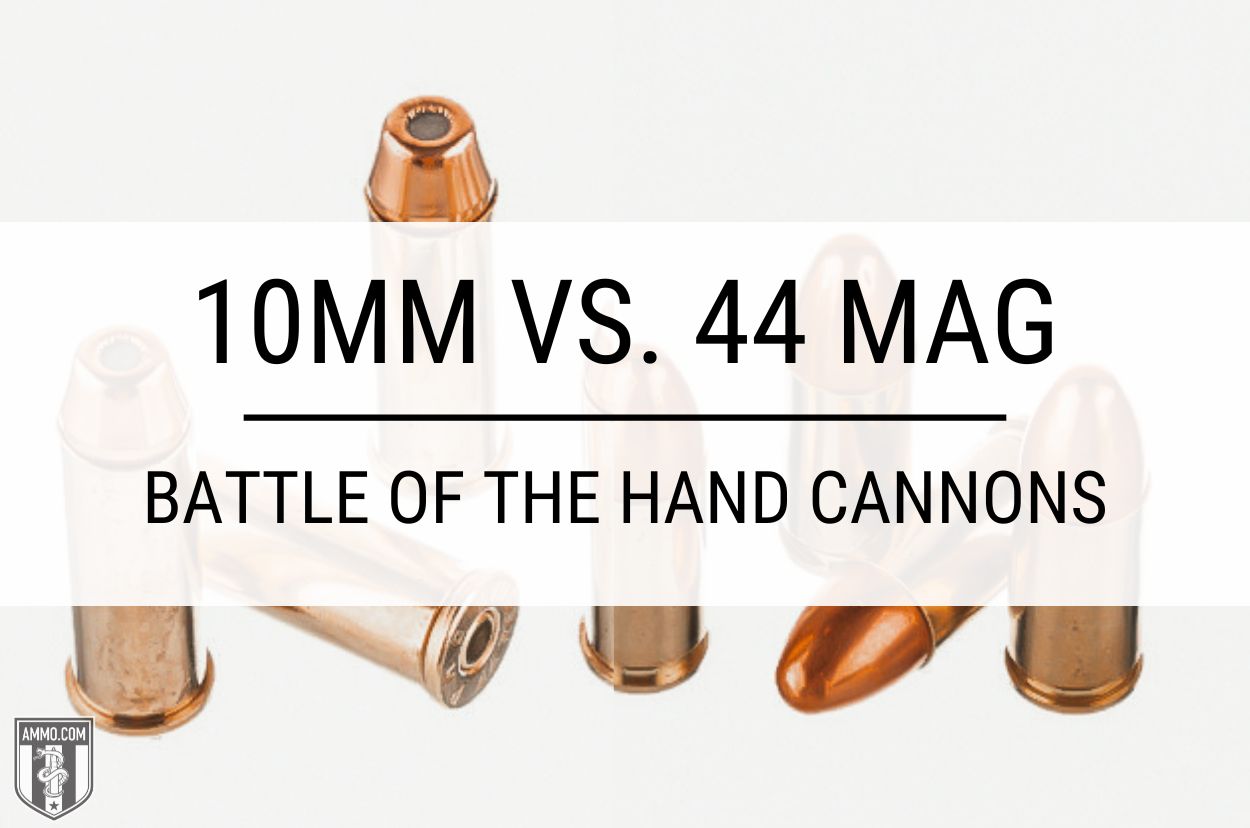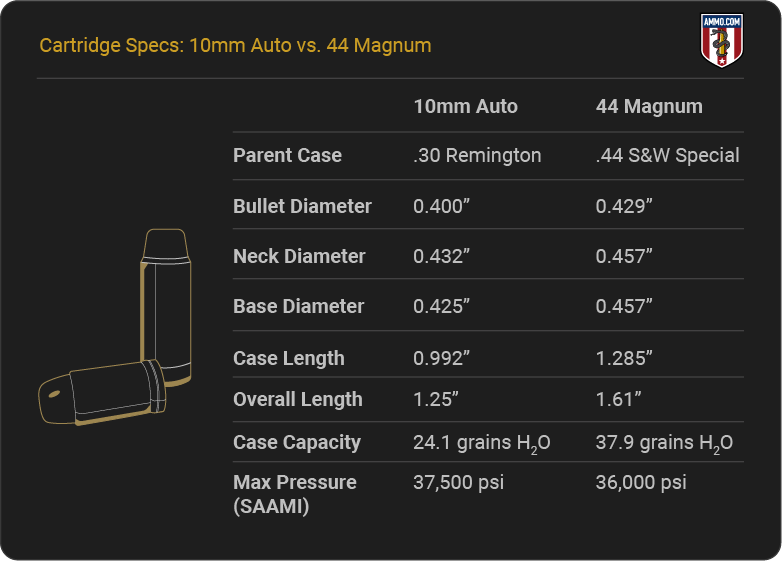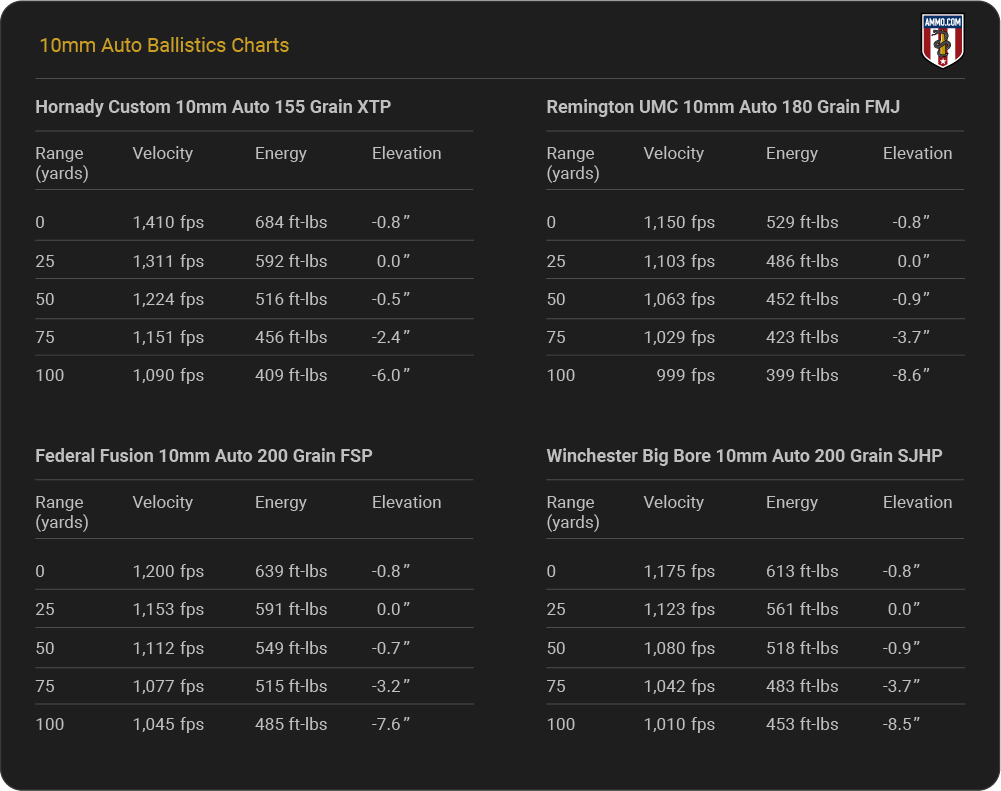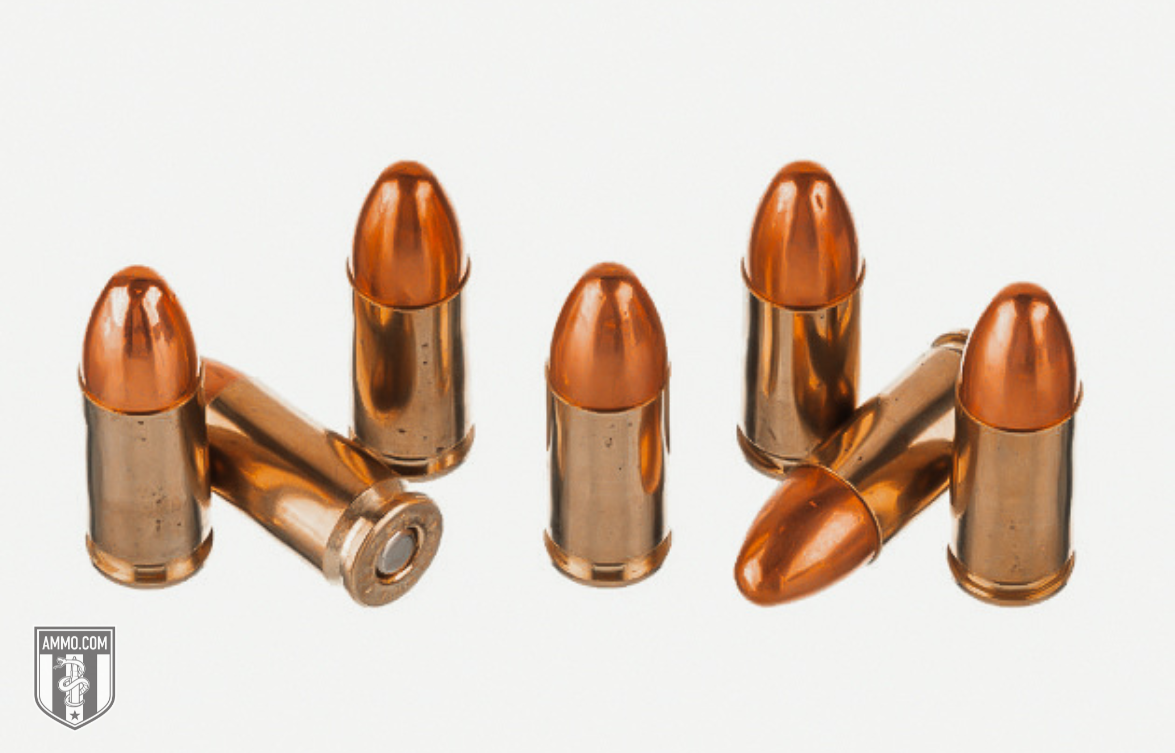10mm vs 44 Mag: Battle of the Hand Cannons

Deciding on the caliber of your self-defense or concealed carry handgun can be a challenging task if you haven’t done your research. Although there are many options on the market like 10mm Auto and 357 SIG, the three most popular pistol calibers are 9mm Luger, 40 S&W, and 45 ACP.
Let’s get started!
10mm vs. 44 Mag Comparison
The 10mm Auto was designed for semi-automatic pistols, whereas the 44 Remington Magnum was intended for revolvers and lever-action carbines (the Magnum Research .44 Mag Desert Eagle being an exception). While many fundamental differences between the cartridges do exist, they also share many similarities.
We’ll begin by discussing each cartridge's technical specifications. We’ll follow with a discussion on how these specs affect real-world performance in areas such as recoil, stopping power, and overall cost.
Cartridge Specs
It’s easy to tell these two cartridges apart at first glance. The 44 Rem Mag is longer (1.61” vs. 1.25”) and has a larger base diameter (0.457” vs. 0.425”) than the 10mm Auto.
The base of the 44 Mag case also has a rim (which it needs in order to chamber in a revolver cylinder), whereas the 10mm is rimless. The 10mm case instead has an extractor groove, which facilitates operation in a semi-automatic platform.
Though there is some overlap, the 44 Mag generally fires larger, wider, heavier bullets than the 10mm. 44 Mag bullet weights typically range from 180 to 240 grain but can go as much as 305 grains, whereas 10mm bullets usually range from 130 to 200 grain.
One might assume that the longer case (1.285” for the 44 Mag vs. 0.992” for the 10mm) and higher case capacity (37.9 grains H2O for the 44 Mag vs. 24.1 grains H2O for the 10mm) of the 44 Remington Magnum would translate into higher maximum pressure. But that’s actually not the case. The 10mm has a higher SAAMI-approved max pressure of 37,500 psi, whereas the 44 Mag has a slightly lower max pressure of 36,000 psi.

Let’s move on to see how the cartridge specifications affect the recoil of each cartridge.
Recoil
Recoil is a critical consideration when purchasing a new handgun. A round with heavy recoil (aka “muzzle flip” or “kick”) will be more challenging to control and effectively slow down the rate of the shooters' follow-up shots.
Recoil is the product of propellant weight, muzzle velocity (fps), bullet weight, and firearm weight. The faster a bullet exits the barrel, the harder it kicks back on the shooter. (That’s just physics, folks.) A heavier bullet also requires more energy to push it out of the barrel at the same muzzle velocity as a lighter bullet, which is returned to the shooter’s wrists.
Although the 44 Magnum and 10mm pack a punch with high kinetic energy, there is a price to be paid for all that power. That price is paid in recoil, which is why some shooters call these cartridges “hand cannons."
44 Mag firearms, such as the single-action Ruger Blackhawk and semi-auto Desert Eagle, are relatively heavy. That extra weight absorbs some recoil energy. Many ammunition makers also intentionally load their 44 Magnum cartridges light to help reduce recoil. Because full-power 44 Mag rounds are often unnecessary for self-defense (excluding defense against bears), the additional muzzle velocity is widely considered not worth the drastic increase in recoil.
The 10mm is often chambered in polymer-framed pistols, which weigh less and thus absorb less felt recoil. However, the 10mm Bren Ten weighs almost twice as much as the 44 Mag CA Bulldog, so there is a wide range of firearm weights chambered in 10mm.
Felt recoil is subjective and varies from shooter to shooter, so we’ll use free recoil to determine which cartridge objectively has less recoil.
A 10mm firing a 180 grain bullet generally has about 11.4 ft-lbs (foot-pounds) of energy. While this doesn’t seem like much, it translates into a snappy pistol-firing experience.
A 44 Mag firing a 240 grain bullet will have about 10 ft-lbs of energy. Slightly less, and most shooters will struggle to tell a difference. However, if we step up to a 44 Mag Buffalo Bore 305 grain lead flat-nose hard cast bullet, the recoil leaps to 30 ft-lbs, on the level of many rifle cartridges.
This section is a tie. Generally, the 44 Magnum will have slightly less recoil, especially when firing similarly heavy projectiles from similar firearms. Still, the difference is barely noticeable, and the 44 Mag can jump to much more recoil when firing heavier projectiles at higher velocities.
Accuracy
The accuracy of a round is affected by many factors, including the shooter, bullet, firearm, and environmental conditions. The trajectory and recoil also play a role, as it’s much easier to be accurate with a round with low recoil and a flat trajectory.
Assuming that we are firing a handgun (long guns tend to be more accurate, and they’re easier to control), it’ll boil down to personal preference, ammo selection, and the firearm as to which cartridge you are more accurate with.
The slight difference in recoil shouldn’t cause a shooter to flinch more with one than the other unless you’re firing lightweight 10mm bullets and heavy 44 Mag bullets. I was surprised by how accurate I could be with my .44 Mag DE and I’ve heard that the 10mm is pretty snappy, making it challenging to be accurate.
This section is also a tie because it ultimately boils down to personal preference.
Stopping Power
Stopping power is a ubiquitous term thrown around campfires, gun forums, and gun store counters. It is entirely unquantifiable, making it a term lacking value, but it sounds essential. The important thing to remember is that shot placement is more critical than “stopping power.” A well-placed shot with a small cartridge like the .22 LR will always be more effective at stopping a threat than a poorly placed shot with a larger cartridge like the .45 Long Colt.
That said, we can argue about bullet hole size, penetration, and energy transfer capabilities until we're blue in the face.
The 44 Mag fires a larger projectile, which maintains a higher energy downrange. You also have the option for hard cast bullets, which are known for their penetration abilities (and pretty much exclusively used for hunting and defense against dangerous game).
The 10mm fires a narrower (and usually lighter) projectile and maintains less energy downrange. However, hard cast bullets are also available in 10mm, so you can still get plenty of penetration from it.
Both cartridges have more than enough stopping power, which is why they’re both used for bear defense. However, I would argue that the 44 Mag has a little more stopping power because it creates a larger hole and is more likely to penetrate deeper.
The 44 Mag wins this section.
Hunting
The 44 Magnum is an excellent big game hunting cartridge, and has remained popular for that application for decades. The Smith & Wesson Model 29 and Ruger Redhawk have longer barrel lengths, making for incredibly accurate revolvers. The Marlin Model 1894 lever action rifle is another favorite deer hunting rifle, especially in states that restrict bottle-necked cartridges for deer hunting.
The 10mm can ethically harvest deer, but its primary “hunting” use is bear defense. It just doesn’t maintain very much energy downrange, making its effective range for large game fairly limited.
The 44 Mag wins this section because it is much better suited for hunting big game animals.
Self-Defense
Many characteristics make up a quality self-defense cartridge. High magazine capacity, accuracy, quick reload time, and lower likelihood of overpenetration are a few that I always consider.
We know that neither of these rounds lacks stopping power, and they're comparably accurate in the hands of a competent shooter.
The 10mm was initially intended to replace the 9mm and 45 ACP for military operators and law enforcement officers. Self-defense enthusiasts have also realized the 10 mm's benefits, but it didn’t outperform the 9mm or 45 ACP enough to make them obsolete.
The 44 Rem Mag is a poor choice for self-defense because it’s overpowered for human-sized targets, and can easily endanger innocent bystanders. Reloading 44 Mag revolvers is much slower than slapping in another magazine, and 44 Mag semi-auto pistols are heavy, bulky, and have much lower magazine capacities than the 10mm.
The 10mm is the clear winner for self-defense.
10mm vs. .44 Magnum for Bear Defense

For those braving grizzly and black bear country, the 10mm and 44 Mag are two of the top cartridges recommended by Alaskan natives. Ask anyone from Alaska: Bear spray is nice, but it doesn’t always work – and when it doesn’t work, you better hope you have something else that does.
Each cartridge has a significant advantage over the other.
When chambered in a pistol like the Glock 20, the 10 mm Auto has a drastic advantage regarding magazine capacity. A typical 44 Mag wheel gun has a 5- or 6-round capacity, whereas the Glock 20 mag capacity is 15. I’ve never encountered a bear in the wild. But if I crossed paths with one, I seriously doubt I’d leave the situation wishing I had less ammo.
The 44 Mag has a higher muzzle energy, so more stopping power is transferred to the bear. But for the terminal ballistics to stop an attacking bear in its tracks, you have to hit it in the vitals – and you likely only have six attempts to hit it with a 44 Mag.
The 10mm has a better advantage as a bear defense round because it still has plenty of stopping power (especially when combined with hard cast bullets), and over double the magazine capacity.
The 10mm Auto wins this section.
Firearm & Ammo Cost
We’re all restricted to what we can afford. While neither round is easy on the wallet, the 10mm is much more budget friendly.
Most 10mm Auto pistols, like the Glock 20, cost under $1,000. FMJ ammo costs about 20 cents less per round, and JHP ammo can cost 40 cents less per round.
44 Mag revolvers like the Taurus 44 Tracker are often found at around $650, but many high-quality revolvers cost over $1,000. The Magnum Research Desert Eagle costs much more, but man is it fun to shoot until your wife finds the ammo bill. Speaking of 44 Mag ammo, Hornady Custom 200 grain XTP is about 35 cents more per round than 10mm Hornady Custom 180 grain XTP.
If you’re looking for the budget-friendlier option, then the 10mm Auto is what you should get … but neither is cheap.
Reloading
Reloading is an excellent option for saving money on ammo. However, it takes a significant initial investment in money and time.
Since 10mm and 44 Mag ammo are expensive, it’s well worth investing in a reloading press and supplies, no matter which one you purchase.
Both cartridges have plenty of reloading information and materials, so this section is a tie.
10mm vs. .44 Magnum Ballistics
For the number lovers, the team at Ammo.com has gathered the ballistics for both cartridges. Please enjoy until your heart's content!
10mm Ballistics

Note: This information comes from the manufacturer. The actual ballistics obtained with your firearm can vary considerably from advertised ballistics. Also, ballistics can vary from lot to lot with the same brand and type load.
Don’t miss our deep dive into 10mm Auto ballistics!
.44 Magnum Ballistics

Note: This information comes from the manufacturer. The actual ballistics obtained with your firearm can vary considerably from advertised ballistics. Also, ballistics can vary from lot to lot with the same brand and type load.
Don’t miss our deep dive into 44 Magnum ballistics!
10mm Brief History
The 10mm Auto was created to have a flat trajectory and stop threats at longer ranges than the beloved 45 ACP. Lt. Col. Jeff Cooper teamed up with Whit Collins and Irving Stone to bring the 10mm into existence.
It started slowly, but Colt provided some credibility when they made the 1911 Delta Elite chambered in 10mm. The FBI eventually adopted the 10mm, but ultimately determined that it had too much recoil for field agents.
Today, the 10mm is more of a niche cartridge: most often used for bear defense, and by a few self-defense enthusiasts who don’t mind carrying a hand cannon as their EDC.
.44 Magnum Brief History
Elmer Keith developed the .44 Magnum in 1954. Smith & Wesson released the first revolver chambered in .44 Mag in 1956. It’s been featured in movies and used by law enforcement officers, civilians, and hunters for decades.
It’s proven its worth in many areas over the years, but hunters primarily use it today for bear defense and as a deer hunting cartridge.
Parting Shots: 44 Mag vs. 10mm
You made it to the end of our 10mm vs. 44 Mag comparison! It’s time to tally up the score and see which handgun cartridge reigns supreme.
The 10mm won three sections (self-defense, bear defense, and overall cost). The 44 Mag won two sections (stopping power and hunting). Three sections were a tie (recoil, accuracy, and reloading).
The 10mm is the overall winner, but if you’re using the cartridge for hunting purposes, the 44 Magnum is often the better option.
Whichever one you decide on, you can fulfill all your ammunition needs at Ammo.com!
Ammo Comparisons
- .308 vs 5.56
- 6.5 Creedmoor vs .308
- .300 Blackout vs .308
- .300 Win Mag vs .308
- .243 vs .308
- .308 vs .30-06
- 7mm-08 vs .308
- .270 vs .308
- 7.62x39 vs .308
- .223 vs .308
- .338 Lapua vs .308
- .380 ACP vs 9mm
- .223 vs 5.56
- .300 Blackout vs 5.56
- 9mm vs 45 ACP
- 9mm vs 40 S&W
- .357 SIG vs 9mm
- 10mm vs 9mm
- 9mm vs 9mm Luger
- .243 vs .270
- .300 Win Mag vs .30-06
- .270 vs .30-06
- .40 vs .45
- 38 Special vs 357
- 9mm vs 40 vs 45
- 5.56 vs 7.62x39
- 338 Lapua vs .30-06
- .30-30 vs .30-06
- 300 PRC vs 338 Lapua
- .30-06 vs 7mm
- 300 Win Mag vs 338 Lapua
- 300 PRC vs 300 Win Mag
- 300 WSM vs 300 Win Mag
- 338 Win Mag vs 338 Lapua
- 12 Gauge vs 20 Gauge
- 10mm vs 357 Mag
- .30-30 vs 7.62x39
- 224 Valkyrie vs 22-250
- 17 HMR vs 22 Mag
- 7.62x39 vs .300 Blackout
- 45 ACP vs 45 Auto
- 45-70 vs 30-30
- 300 Blackout vs 223
- 357 Magnum vs 9mm
- 350 Legend vs 300 Blackout
- 224 Valkyrie vs 223
- 45 ACP vs 38 Super
- 6.5 Grendel vs .308
- 17 HMR vs 22 LR
- 10 Gauge vs 12 Gauge
- 22-250 vs 223
- 45 Colt vs 45 ACP
- 350 Legend vs 30-30
- 5.7x28 vs 223
- 5.7 vs 9mm
- 5.56 vs 5.7
- 22 vs 9mm
- Buckshot vs Birdshot
- 450 Bushmaster vs 308
- 450 Bushmaster vs 223
- Buckshot vs Slug
- 6.5 Grendel vs 5.56 vs 223
- 6mm ARC vs 6.5 Grendel
- 44 vs 45
- 458 SOCOM vs 5.56
- 357 vs 44
- 32 ACP vs 380
- 300 Win Mag vs 338 Win Mag vs 338 Lapua Mag
- 450 Bushmaster vs 458 SOCOM vs 50 Beowulf
- 6mm Creedmoor vs 6.5 Creedmoor
- TMJ vs FMJ
- 44 Special Vs 44 Magnum
- 45 90 vs 45 70
- 6.8 Western vs 6.8 SPC
- 50 Beowulf vs 50 BMG
- 26 Nosler vs 6.5 PRC
- 28 Gauge vs 410
- 6.8 SPC vs 5.56
- 6.8 SPC vs 6.5 Grendel
- 6.8 Western vs 7mm Rem Mag vs .28 Nosler
- 6.8 Western vs 6.5 Creedmoor
- 22 Hornet vs 223
- 6.8 Western vs 6.5 PRC
- .410 vs 12 Gauge
- .410 vs 20 Gauge
- 22 LR vs 22 Mag
- 6mm ARC vs 243
- 7mm-08 vs 270
- 243 vs 6.5 Creedmoor
- Nickel vs Brass Casing
- 204 Ruger vs 223
- 50 Beowulf vs 5.56
- 260 Remington vs 6.5 Creedmoor
- 6mm Remington vs 243
- 28 Nosler vs 300 PRC
- 50 Beowulf vs 50 AE
- 22 Nosler vs 22-250
- 450 Marlin vs 45-70
- 300 Win Mag vs 300 Norma
- 458 SOCOM vs 300 Blackout
- 38-55 vs 45-70
- 22 Hornet vs 22 LR
- 300 Norma vs 338 Lapua
- 338 Lapua vs 50 BMG
- 28 Nosler vs 300 Win Mag
- 28 Nosler vs 6.5 Creedmoor
- 204 vs 22-250
- 458 SOCOM vs 45 70
- 44 40 vs 45 70
- 6.8 SPC vs 6.5 Creedmoor
- 450 Bushmaster vs 30-06
- 7mm Rem Mag vs 300 Win Mag
- 30 Carbine vs 223
- 25-06 vs 30-06
- 26 Nosler vs 28 Nosler
- 16ga vs 12ga
- 30 06 vs 7.62 x54R
- 9mm Makarov vs 9mm Luger
- 350 Legend vs 223
- 30 Carbine vs 5.56
- 6.5x55 vs 6.5 Creedmoor
- 6.5 Creedmoor vs 270 vs 25-06
- M193 vs M855
- 450 Bushmaster vs 458 SOCOM
- 6.5 Grendel vs 6.5 Creedmoor
- 350 Legend vs 5.56
- .277 Fury vs 6.8 SPC
- 277 Fury vs 300 Win Mag
- 10mm vs .45 ACP
- 277 Fury vs 223
- 6.8 SPC vs 300 Blackout
- 6.5 PRC vs 6.5 Creedmoor
- 277 Fury vs 308
- 277 Fury vs 6.5 Creedmoor
- 350 Legend vs 450 Bushmaster
- 277 Fury Vs 5.56 NATO
- 10mm vs 40S&W
- 32 ACP vs 9mm
- 32 Special vs 9mm
- 8.6 Blackout vs 300 Blackout
- 30 Super Carry vs. 9mm
- 5.56 vs 9mm
- .50 Action Express vs 9mm
- 7.62x25 vs. 9mm
- 10mm vs 44 Magnum
- 300 Blackout vs 300 Win Mag
- 6.5 Grendel vs 300 Blackout
- 460 Rowland vs 10mm
- 300 RUM vs 300 PRC
- 300 Norma vs 300 PRC
- 45 GAP vs 45 ACP
- 7mm PRC vs 300 Win Mag
- 300 PRC vs 6.5 Creedmoor
- 300 PRC vs 308
- 357 SIG vs 357 Mag
- 7.62x39 vs 7.62x51
- 243 Win vs 223 Rem
- 30 Nosler vs 300 PRC
- 6.5 Creedmoor vs. 30-06 Springfield
- 450 S&W vs. 44 Magnum
- 6.5 Creedmoor vs. 300 Win Mag
- 454 Cassull vs. 45-70 Govt
- 454 Cassull vs. 44 Mag
- 7.62x54r vs. 308 Winchester
- 22 ARC vs. 223 Rem
- Subsonic vs. Supersonic Ammo


